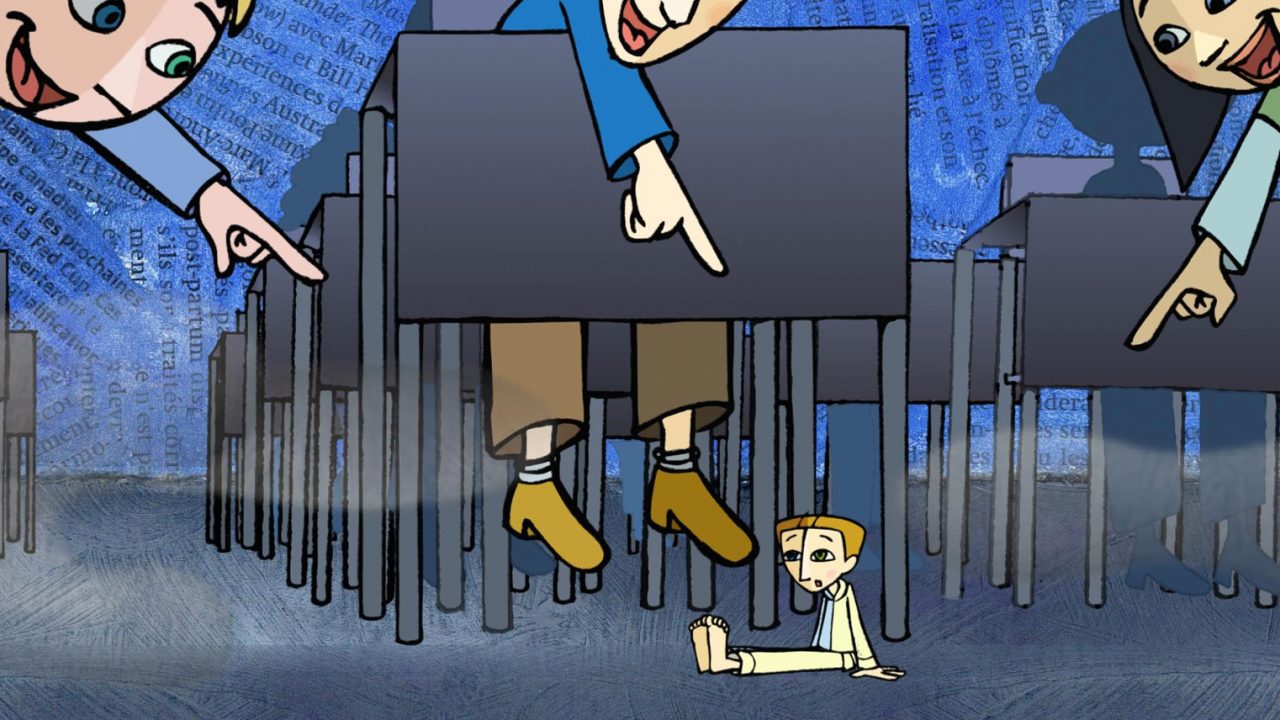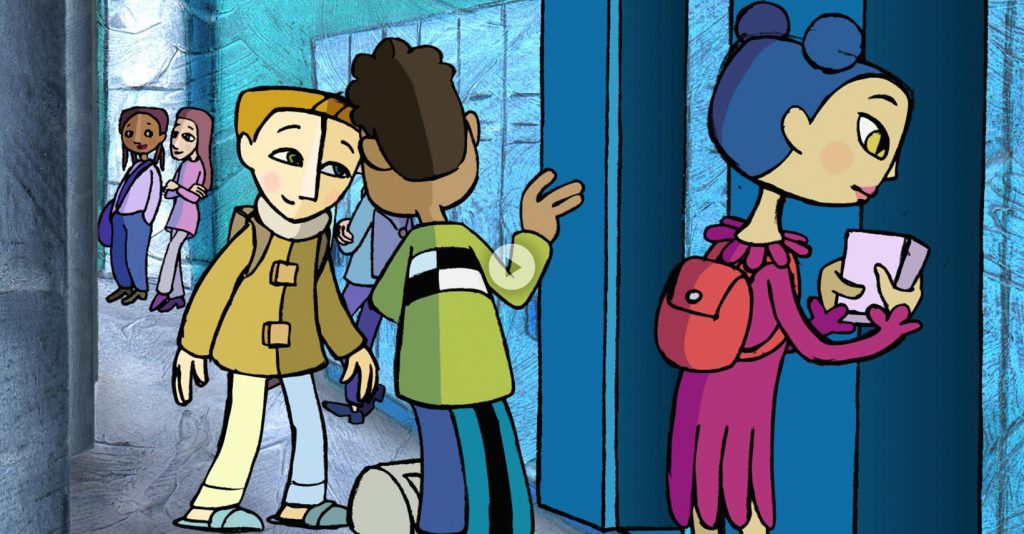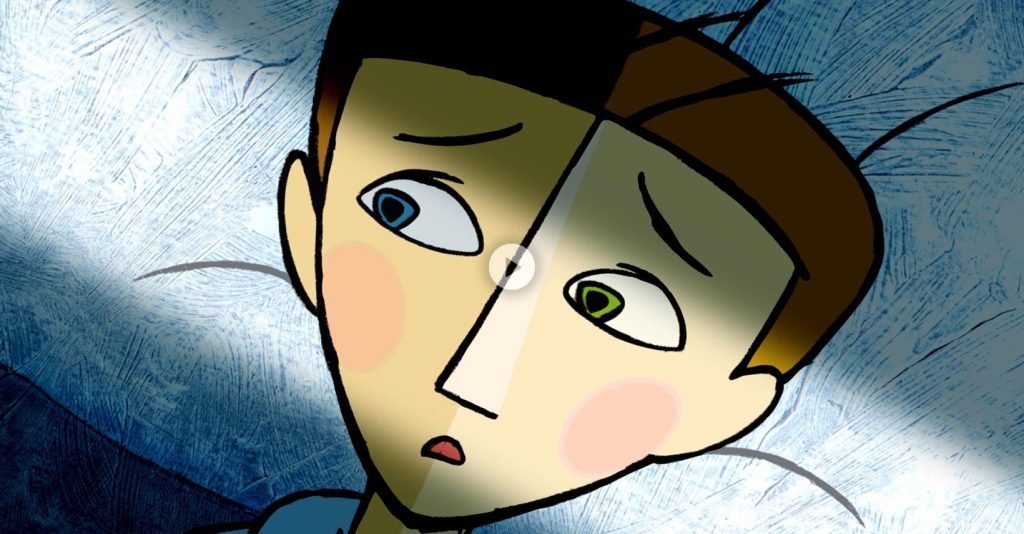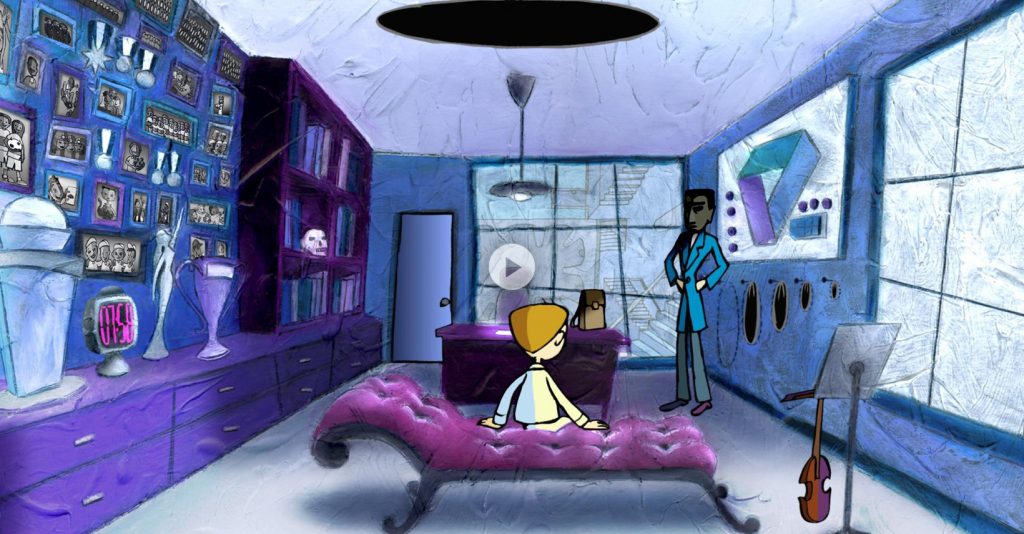
Mini-Lesson for Nightmare at School
Mini-Lesson for Nightmare at School
Mini-Lesson for Nightmare at School
Themes:
- Child Development
- Bullying & Discrimination
- Careers & Education
- Mental Health/Stress
Ages: 5-8
Nightmare at School, Catherine Arcand, provided by the National Film Board of Canada
Guiding Question: Is it normal to be anxious at school?
Summary: Nightmare at School is about a boy who dreams of his day at school. One by one, his worries, fears and anxieties crop up, becoming fearsome obstacles. He will need to muster all his courage and trust in himself if he is to succeed.
Aimed at primary level students, this lesson sets out to promote listening skills as well as explore some of the school-related anxieties children might experience. Depending on attention levels, the three activities could be carried out over three consecutive days.
Activity 1: Films and books: difference and similarities
Have students watch the film right through to the end, though without being shown its title. We’ll return to this at the end of the activity.
Start by giving them time to react. What did the film bring to mind for them? What did they like about it? How did it make them feel?
Next, ask them which they like better, animation or books, and see if you can get them to explain why. After a few responses, suggest looking together at what books and films have in common as well as what makes them different.
Create the list orally, writing down a few words on the blackboard. Even if your students don’t yet know how to read, you can explain that writing things down on the board helps you remember them.
Possible differences
Music and sound effects; movement/animation; use of writing; narration/description vs images.
Possible similarities
A story is told; there are characters; there are drawings; there is an author (and sometimes an illustrator); there is a title.
Since you haven’t yet revealed the film’s title, ask your students to try and come up with a good one. Then compare their ideas with the actual title.
End
This activity starts with a first viewing of the film, after which students freely share their reactions. They are then prompted to consider the similarities and differences between films and books (which may predispose them to see videos viewed in class as more educational than recreational). Lastly, the theme of fear can be approached through their ideas about a title as well as the film’s official title.
Activity 2
Like interactive reading, interactive viewing teaches students to think analytically and enhances their understanding of the work in question. This activity is based on the interactions that occur between teacher and class before, during and after watching the film. This will be students’ second time seeing the film, and is ideally held the day after Activity 1.
Vary the questions so that students can understand, interpret, react and appreciate.
To address the theme of fear of school, here are a few ideas.
Before the screening: “Let’s try to find everything that might worry the student in the film. If you see something that’s a little worrying or scary, raise your hand to tell us.”
During the screening:
- 1:20: “How do you think the boy is feeling? How do you know he’s worried or unsettled? Can you tell by looking at his mouth? His eyes?”
- 1:42: “Why do the kids all start running around? Why do you have to hurry when you hear the bell?” [fear of being late]
- 1:45: “Would you be afraid of getting lost in a school like this? Have you ever gotten lost in a school or store?” [fear of getting lost]
- 1:55: “Who is this man? Should you be afraid of the principal?” [fear of authority]
- 2:30: “Sometimes when you’re scared, you feel really small or helpless. What’s he afraid of? What does he have to do in class today that has him so worried?”
- 2:58: “Is he the only one who’s scared? Why might somebody be scared to get up and speak in front of the whole class?”
- 3:58: “Why does the principal toss a hole under the student’s desk? Is what happens something to be afraid of?”
- 4:38: “Here, the boy is afraid of being different. He’s afraid of people making fun of him. Have you ever done something different that made others laugh at you? Should we laugh at differences?”
- 5:30: “When the boy and girl talk to each other, does it look like a friendly discussion? What do you think they said? Who was right in the end? Does it feel good to be wrong?” [fear of conflict, fear of being wrong]
- 6:48: “The girl whose presentation was about her cat became a vet; the boy who talked about cars became a car salesman. Why is our hero so afraid when he sees his own reflection? Has he given his presentation? If he doesn’t do his schoolwork, then what will he be when he grows up? Can you be afraid of failing at school and not having a job later?”
- 7:07: “Why is he on a diving board? Have you ever jumped into a pool from a diving board? Does this take courage? What should the boy do now?”
Feel free to limit the questions or invent new ones that better suit your class’s level of participation. My suggestions are mainly based on understanding and interpretation, but you can take another approach—for example, looking at the role of colours and music in the film to draw out students’ reactions.
End
This activity prompts students to analyze what they see and hear. By taking short breaks to discuss what’s happening onscreen, students learn to reflect and ask questions as they watch films.
Activity 3
Students compare their own anxieties with those raised in the film. After summarizing the fears experienced by the boy in Nightmare at School, each student makes a drawing of a similar situation (fear of being late, fear of being unable to learn something or complete an assignment, fear of being scolded, fear of being mocked, etc.).
Once they have finished their drawings, students are asked to partner up. One partner explains their drawing to the other, who listens; then the roles are reversed.
The activity can end with a class discussion on the different ways of dealing with fears:
- calming yourself down (deep breathing);
- identifying the cause of the fear to come up with possible solutions;
- asking for help or reassurance;
- staying positive: closing your eyes and telling yourself everything will be okay.
End
This activity aims to have students relate aspects of the film to their own experience. Afterwards, as a group, they can share ideas about how such fears might be overcome.
Take Action: First-year journal
Provide each student with a small notebook. Each week, they can use this notebook to draw or write (their choice) about a worry or success they’d experienced that week at school (learning/socializing). Effectively serving as a journal, the notebook will let them see their amazing progress over the year and show them how they managed to overcome the fears and challenges they had to face.
At this age, children can sometimes struggle to recall what they have done or learned in a given week; they can also have trouble projecting into the future, even the near future. The journal could help them manage their fears and develop healthy self-esteem. It will also let you get to know your students better. During the first few weeks or months, don’t hesitate to give them ideas and prompts if they appear stuck. Introspection is liable to be a new concept for most of them, so they’ll need a little guidance!
Pour lire cet article en français, cliquez ici.
Discover more Mini-Lessons | Watch educational films on NFB Education | Watch educational playlists on NFB Education | Follow NFB Education on Facebook | Follow NFB Education on Pinterest | Subscribe to the NFB Education Newsletter






